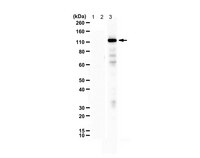ABE2626-25UG Sigma-AldrichAnti-PASD1
Anti-PASD1, Cat. No. ABE2626-25UG, is a highly specific rabbit polyclonal antibody, that targets Circadian clock protein PASD1 and has been tested in Western Blotting and Immunoprecipitation.
More>> Anti-PASD1, Cat. No. ABE2626-25UG, is a highly specific rabbit polyclonal antibody, that targets Circadian clock protein PASD1 and has been tested in Western Blotting and Immunoprecipitation. Less<<Recommended Products
Overview
| Replacement Information |
|---|
| References |
|---|
| Product Information | |
|---|---|
| Format | Purified |
| Presentation | Purified rabbit polyclonal antibody in buffer containing 0.1 M Tris-Glycine (pH 7.4), 150 mM NaCl with 0.05% sodium azide. |
| Physicochemical Information |
|---|
| Dimensions |
|---|
| Materials Information |
|---|
| Toxicological Information |
|---|
| Safety Information according to GHS |
|---|
| Safety Information |
|---|
| Storage and Shipping Information | |
|---|---|
| Storage Conditions | Stable for 1 year at 2-8°C from date of receipt. |
| Packaging Information | |
|---|---|
| Material Size | 25 μg |
| Transport Information |
|---|
| Supplemental Information |
|---|
| Specifications |
|---|
| Global Trade Item Number | |
|---|---|
| Catalogue Number | GTIN |
| ABE2626-25UG | 04054839464676 |
Documentation
Anti-PASD1 SDS
| Title |
|---|
Anti-PASD1 Certificates of Analysis
| Title | Lot Number |
|---|---|
| Anti-PASD1 Polyclonal Antibody | Q3027766 |













